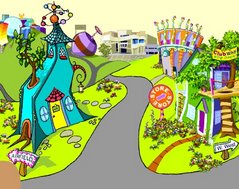Keeping up with Fashion: St. Patrick's Day on Whyville

Well, we've been talking about identification and avatars, and March 17, aka St. Patrick's Day is a case in point for me. First, there's a Whyville party (and probably fashion contest as usual). I don't know whether I'll be able to make it, but today I spent 256 clams on my new Irish look. I have to admit, it parallels my own practice on St. Patrick's Day because it's my birthday. Being both Irish (descent on both sides), red haired (first in four generations on either side), and born on March 17, this has always been an important day for me. Before I understood genetic, I actually believed my mom, who would tell people that I got my red hair because I was born on St. Patrick's day (actually since both parents have brown hair, I was quite a surprise coming out of the womb!).
So historically I would always dress to the tee in green, shamrocks, pins, etc. on March 17. In fact, I had an entire set of shamrock jewelry (necklace, earrings, pins) from my great-aunt before it was stolen in high school. And you wouldn't believe the number of birthday cards there are for people born specifically on St. Patrick's Day! I know, because I've probably been given them ALL.
So I had to dress up not just in person (I made sure to wear all three pairs of socks with clovers/shamrocks, shamrocks & Guinness beer this week) but also in Whyville. After all, some kids took the time to make face parts special for the occasion - I'm only sporting a small percentage of them! I tried to make my own emerald necklace but it hasn't been approved yet.
Supporting the fashion economy of Whyville,
Debbie/Oriahsiri


